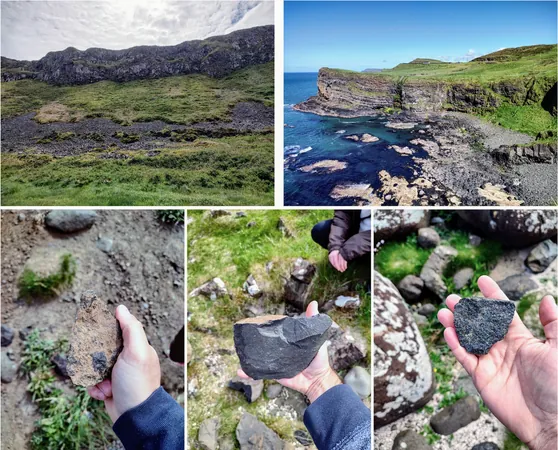
Unveiling the Hidden Truth: How Natural Rocks Inspired the Birth of Stone Tools
2025-03-30
Author: Li
The Catalyst for Stone Tool Creation
The dawn of sharp stone tools, a process known as 'knapping,' revolutionized early human evolution by unlocking access to new food sources. This significant technological advancement played a pivotal role in not only enhancing brain size but also fostering the complex development of human societies.
But what was the catalyst for this transformative moment in history? How did our earliest ancestors first appease their cutting needs with sharp-edged tools?
Nature’s Hidden Arsenal
Recent insights from a groundbreaking study led by a team of 24 scientists at the Cleveland Museum of Natural History propose a refreshingly new hypothesis regarding the origins of stone tool production. According to Dr. Emma Finestone, an associate curator at the museum, along with her colleagues Dr. Michelle R. Bebber and Dr. Metin I. Eren, early humans likely did not begin by intentionally crafting tools, but rather utilized naturally occurring sharp rocks shaped by environmental forces.
Dr. Eren emphasizes a fascinating point: 'There probably wasn't an 'Eureka!' moment for our ancestors when they first created a sharp stone flake. The need to cut must have already been ingrained in their daily lives.' This hints at a time when early hominins took advantage of what they termed 'naturaliths'—naturally occurring sharp rocks crafted by geological processes such as river erosion or animal activity.
Contrary to previous beliefs that considered these natural tools to be rare, recent findings indicate they are, in fact, quite plentiful. Global fieldwork and a meticulous analysis of historical data reveal that such sharp rocks form continuously, often in substantial quantities, across diverse ecosystems.
'If nature can produce sharp rocks in sets of hundreds or thousands, these natural knives were likely abundant and accessible for early hominins,' commented Dr. Bebber, who discovered such a site in Oman. This underscores the idea that our ancestors may have had a ready supply of tools right around them.
Research by Dr. Finestone in Kenya supports this notion, revealing that many sites of early human activity were situated near areas abundant in stone. This suggests that early hominins were likely opportunistic, utilizing readily available sharp rocks for various tasks, from processing animal remains to handling tough plant fibers.
A Gradual Path to Knapping
The team posits that as hominins grew comfortable with using sharp edges found in nature, evolutionary pressures would have compelled them to create their own tools, particularly in regions where naturaliths were scarce, or for tasks requiring precise tool manipulation.
Knapping perhaps did not emerge as an instantaneous invention but rather as a gradual adaptation driven by practical needs: 'How could early humans create sharp rocks on demand, in varied environments, tailored for specific tasks?'
Dr. Eren states, 'We believe this hypothesis is the most parsimonious explanation for the origins of hominin stone technology yet, but it calls for further archaeological investigation.' Their research aims to uncover evidence of naturalith use by hominins dating between 3 to 6 million years ago, which, if validated, could dramatically shift our understanding of human technological behavior timelines, pushing them back by hundreds of thousands, if not millions, of years.
Current tools created through knapping are dated to at least 3.3 million years ago, but if natural stones were used first, it could suggest that the foundation of technological innovation lies much deeper in our prehistory than previously thought.
A Shift in Perspective
This new perspective challenges the notion of a single transformative moment in toolmaking, suggesting instead a gradual evolution influenced by the resources at early humans' disposal. The recognition of sharp edges likely preceded the knowledge of how to create them, leading to innovation born from observation and adaptation rather than mere invention.
As researchers delve into the archaeological record for signs of naturalith usage, this theory opens exciting avenues for understanding the intricate relationship between early humans and their environment, starting with the simplest yet powerful cutting tools nature provided.
This groundbreaking study is published in the journal Archaeometry, heralding a new era of exploration into our ancestors’ ingenious adaptations and their indelible impact on the trajectory of human civilization.
Stay tuned as we continue to unpack the mysteries of our past—who knew that the keys to understanding human evolution lay in the very rocks under our feet!


 Brasil (PT)
Brasil (PT)
 Canada (EN)
Canada (EN)
 Chile (ES)
Chile (ES)
 Česko (CS)
Česko (CS)
 대한민국 (KO)
대한민국 (KO)
 España (ES)
España (ES)
 France (FR)
France (FR)
 Hong Kong (EN)
Hong Kong (EN)
 Italia (IT)
Italia (IT)
 日本 (JA)
日本 (JA)
 Magyarország (HU)
Magyarország (HU)
 Norge (NO)
Norge (NO)
 Polska (PL)
Polska (PL)
 Schweiz (DE)
Schweiz (DE)
 Singapore (EN)
Singapore (EN)
 Sverige (SV)
Sverige (SV)
 Suomi (FI)
Suomi (FI)
 Türkiye (TR)
Türkiye (TR)
 الإمارات العربية المتحدة (AR)
الإمارات العربية المتحدة (AR)